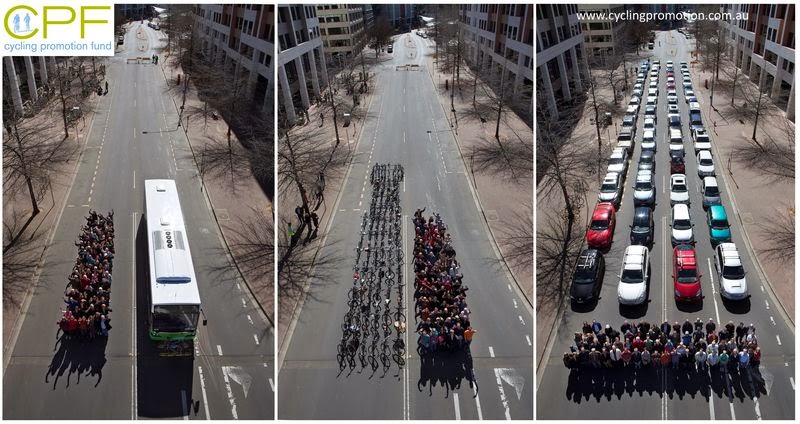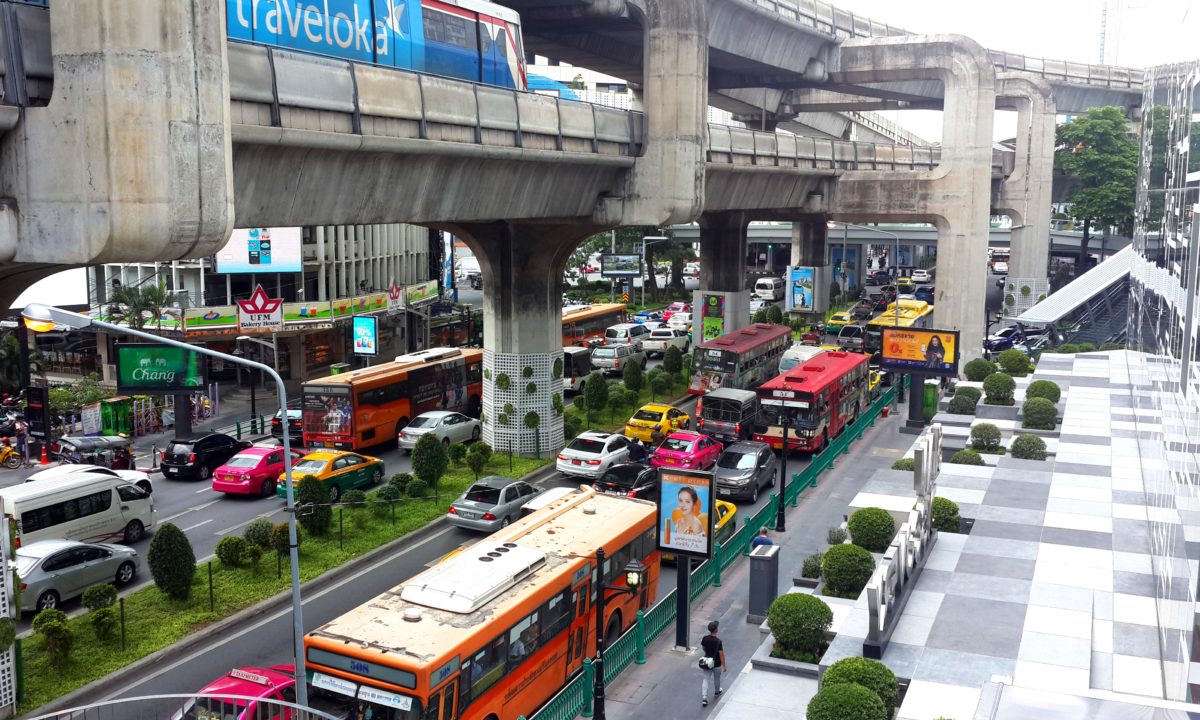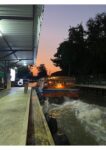Photo credit: M. H. Benton (2018), Bangkok, Siam Shopping District
Volume 1, Number 5: October 2018 | Editorial
The topic of traffic gets a lot of attention here in Bangkok, especially among my students who are interested in urban economics. Numerous complaints about terrible commutes, which can last up to two hours one way, are to be expected when average time spent sitting in traffic is around one hour in each direction. Most of the complaints I hear about are from automobile drivers, which is a key part of the problem. While most motorists, I would agree, have very undesirable commutes, imagine for a moment how the trips for bus commuters actually are, particularly those for whom the other modes are not feasible options. If the residents of Bangkok are serious about reducing commute times for all commuters, not just motorists, I suggest we take an honest look at the root of the problem and then I will offer some technical and non-technical solutions.
The first source of the congestion problem facing Bangkok is economic in that it is an urban giant, which is disproportionately attracting migrants to the city despite being easily considered to far exceed its efficient scale in terms of population. Roughly twenty-five percent of the population has located in this metropolitan area. While I will not address migration specifically in this paper, this reflects a coordination failure that will most likely require government to incentivize migration to other urban areas through investment and development which would ease the pressure on the resources and space of Bangkok.
From a technical perspective, the problem is that road space expansion is limited, due to existing infrastructure in the city; and the road structure with the soi/sub-soi layout makes substitution for alternative routes difficult, if not impossible. This means that the ability to solve this problems from an engineering perspective involving road expansion will not be addressed. I will assume these as constraints that we cannot easily relax. Therefore the solutions will have to figure out how to use existing road space more efficiently and equitably.
The problem is also systemic. Auto ownership is increasing. In a political-economic system which has a powerful automobile and fossil fuel lobby, it is not surprising that automobiles are being encouraged through marketing and are granted a privileged status in terms of public infrastructure; while pedestrians, cyclists, and buses are neglected. It is reasonable to assume that these industries will resist investments in alternatives to their primary source of profits.
The problem is also social. Cars, especially luxury brands, are seen as a status symbol, so owning and driving a car is granted a privileged status in the eyes of society, which encourages more auto usage. This is a problem that requires a non-technical solution. Alternatives to the cars are seen as substandard, and in a very class-conscious society, these will always be neglected, even if they have great potential for improved urban mobility.
Mass transit tends to be viewed favorably, for the most part, especially among the middle class, but is limited in its functionality in the short term. I argue that this is not the solution to congestion, because, depending on the plan of expansion, it could make things worse by encouraging location decisions that could exacerbate the problems rather than fixing them. At the
very least, it could shift the congestion problem to the mass transit lines, which is currently happening along the BTS and MRT. Mass transit receives a lot of attention, because it is easy to imagine emulating the sophisticated transit systems of Japan, Singapore, Europe, and others advanced urban areas. But economically, it does not make the most sense unless you consider the context and resources available, the realized benefit, how widely shared the benefits will be, relative costs, and the time it takes to develop. While leapfrogging technology makes sense in some areas; in transportation, and for mass transit specifically, a robust bus system is critical to serve as a backbone. When the mass transit lines face even a moderate disruption, this could lead to huge systemic failure when too many people are dependent on the trains and do not have good alternatives to fall back on. All of the advanced urban areas mentioned above also
have excellent bus services to complement their mass transit system. It would be foolish to neglect this, while promoting mass transit, even though it is easy to do when the buses are perpetually viewed as lower class.
My technical solutions revolve around the bus as a robust backbone of the overall system. Along with upgrading the bus system must come a plan for road space management. This solution is based on the model of the existing BRT (bus rapid transit) line, which is a good idea in principle, but is incompletely implemented, primarily due to the significant amount of unoccupied road space between buses.
Here I must suggest a rationing device for allocating road space. Typically, an economist would approach the problem of congestion using a price mechanism for rationing, such as a congestion charge or a cordon fee, which would likely disproportionately benefit the rich, but, depending how the revenues are recycled, could actually make all current road users worse off. Since social equity is key priority of mine, I instead advocate for allocating the road based on a principle which prioritizes road users according to the amount of road space required per person transported, but also considering speed and energy required per person to move a given
distance, which is also important for sustainability implications of urbanization.
How much space do different users require? Well let’s start with the typical bus. A bus can carry about 90 passengers and uses about two-to-three times the amount of road space of a private passenger automobile. A bicycle can use less than one-tenth the space of a standard automobile, but since this refers to parked bicycles, I would suggest a much more conservative estimate of six moving bicycles. In a single occupant vehicles, it is clear that the cyclists use less road space. However, if motorists are carpooling, they become closer in terms of space requirements.

(Public Domain)
In terms of energy efficiency, velomobiles are the most efficient of all vehicles and they can travel speeds of up to 50 kph. While still uncommon, they are human powered and are covered to protect against the elements, but are also designed for aerodynamics. It uses about 1/50 the amount of energy of a personal car. The space requirements are only a slight improvement over the private car, however. On the other hand, a standard bicycle requires between 10-25 times less energy per distance traveled than a personal car. A bus with 55 rider potential at full capacity can achieve 140 passenger kilometers per liter of diesel fuel or 98 passenger kilometers per liter at 70% capacity. Compare this to a relatively fuel efficient passenger vehicle, which would get 10 km/L. When electric vehicles come to dominate, we may have to change the calculation a bit. But while these are just some very rough estimates, since this central argument is not predominantly focused on energy efficiency, I think this can adequately serve the purpose of an ordinal ranking of road users. The following images illustrate the space requirements for three different road users.

The solution, in principle, is simple. Let’s start by removing all users so we begin with an empty road. Who should be the first to be allocated road space?
While human-powered transport (bicycles and velomobiles) should rank high due to its low energy requirements and modestly lower space requirements, the slower speeds count against this mode. Buses, while they use the least amount of space per person, can move people faster than human-powered vehicles and use much less energy per person than a car. Keep in mind, automobiles also require space for parking, which may also encroach upon road space. The cars which require the most space and energy per person should be given the lowest priority. With these factors under consideration, I would grant the bus the highest priority by dedicating one lane of road space for all buses to use, as is currently done with the BRT line. Is there any space remaining? If so, the space in between buses can be filled with cyclists and motor bikes, as long as they do not impede the mobility of the buses. Remaining lanes can be allocated to private automobiles.
The logic is simple, no matter how nice you make the buses, as long as they are subject to the same traffic congestion as the cars, people will not switch away from cars. Why not spend that time in your own private space? In order to encourage a switch, you have to create a competitive advantage for the bus, that being the time-cost savings, which is a significant part of the
commuting costs. I would expect that in equilibrium there will still be many car users stuck in traffic, but if they look over and see a free-flowing lane of buses moving large numbers of people much more quickly and comfortably, a motorist will rethink whether sitting in a private status symbol is really worth the extra time of sitting in traffic. Even if it is worth it to the driver, at least his or her decision is not going to impose external costs onto the ones who are willing to share space. It will only affect other drivers. Since the primary objective of the dedicated lanes is the keep perfect mobility, this could serve emergency vehicles very effectively; as opposed to the current situation, which leaves ambulances stranded with nowhere to go. I have always been afraid of needing an ambulance in this city.
Some two-lane roads (one lane in each direction) could be converted into one-ways, which would create one bus/bike lane and one automobile lane, which would still make private residences and retail establishments accessible by car, albeit less conveniently. For the major six-lane roads, such as Sukhumvit, the dedicated lane could be in the center which would allow passengers to be picked-up/dropped-off in the median. A passenger overpass could then be placed at each bus stop, so passengers would not have to cross lanes of traffic. This would again allow residences and retail establishments to be accessible by vehicle. I would even consider switching the direction of the flow of the middle lanes to prevent would-be encroachers from entering that lane.
The time of day could also be an important consideration for adjusting various permitted uses. For example, there could be flex lanes that may open up to more uses outside of the prime commuting hours. Delivery trucks could be granted access only during certain hours. The other technical solutions that should be addressed in a future discussion would include how to design U-turns and intersections. These can be conceivably well managed with proper signals which can still give priority to buses by allowing drivers to control the signal upon approaching, as is already done in many systems. Driving skills and manners also make a big difference in reducing congestion. Blocking intersections is a significant issue which leads to more congestion than is inevitable.
While not necessarily a discussion of road use, I will mention some considerations for public transit in general. One benefit of the bus system over mass transit in the short-to-medium run would be that it is more cost effective to get up and running. It would be quicker to put in place, given that the roads are already there. It would just require some minimal infrastructure which is much less costly than extending heavy rail. Another key advantage is the flexibility. Once a mass transit system is built, changes are very costly. Buses can be rerouted fairly easily, if the initial plan is determined to be undesirable. Lastly, a simple breakdown of a single bus is not going to bring down the entire system, while a simply malfunction of the BTS/MRT radio networks or a single train can halt the entire system for hours, causing major disruption.
My non-technical solutions include upgrading the buses for aesthetics and comfort in an attempt to reduce the social stigma of using the buses. Everyone should be able to use these public services, but it is equally important that everyone would want to use them. I would even suggest that while in office, all elected government officials should be required to use the bus system, because then it will get the attention it deserves. As long as the ones making decisions about these services do not use them personally, the quality will be neglected. Cleaning up the buses from the outside, in terms of reduced emissions, will also benefit would-be cyclists.
As Joseph Stiglitz once put it, “A traffic jam of Mercedes in a country with a per capita income of $4,730 (as it was was in 1997 [referring to Russia]), is a sign of sickness. It is a clear sign of a society that concentrates its wealth among the few, rather than distributing it among the many.” A similar sentiment has been echoed by many, notably, by a relatively famous quote attributed to Enrique Peñalosa Londoño, the 793rd and 798th Mayor of Bogotá, Colombia, “An advanced city is not a place where the poor move about in cars, rather it’s where even the rich use public transportation.” I do not have a specific solution for changing social norms, other than advocate for cleaner, more ecologically friendly, socially-inclusive modes of transport that everyone can be proud to use. I personally do not own a car and am quite happy without one. I think that when we can demonstrate the benefits of the alternatives, there is potential for growing enthusiasm. I am one of the would-be cyclists and, if these changes were made, I would switch from my current use of mass transit to getting around town quickly by bus and bicycle. There is a growing wave of cyclists who are willing to risk the roads in their current condition. These people deserve the highest respect, not the drivers of the Mercedes, because the cyclists are risking their lives to pave a path for a better urban transit infrastructure for the rest of us.
Solutions proposed in the essay will undoubtedly face opposition from powerful interests. In order to be successful, there needs to be effective management, which is also a large obstacle. However, I am optimistic that as people’s attitudes change, as I do see happening gradually, even without perfect management, things can be improved as more people contribute to
solutions, rather than desperately hold on to outdated values. I would argue that as long as cars are viewed as a status symbol, there will also be streets jammed with automobiles. For those who still place a high value on the status of driving a car, they can still drive, but must be prepared to sit in traffic. Everyone else should not be forced to suffer longer commutes because of the status desire of certain individuals. Cities around the world are changing by shifting away from automobiles, Bangkok should too.











































